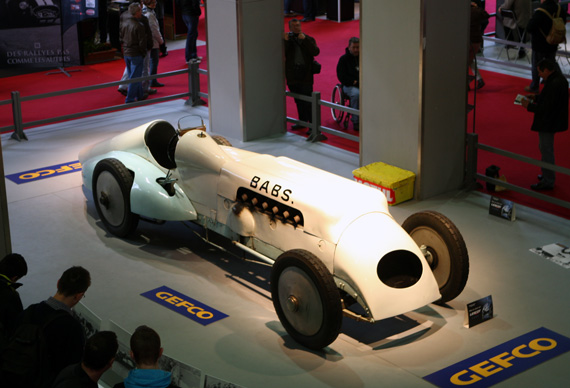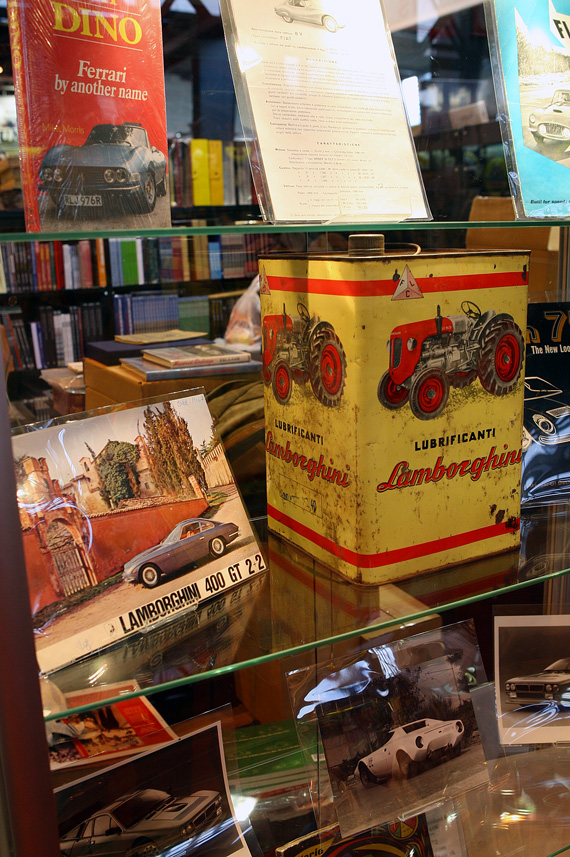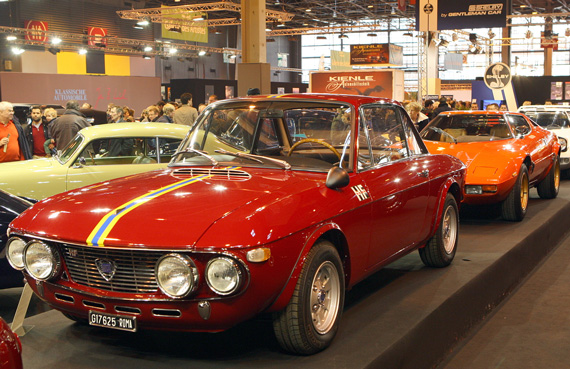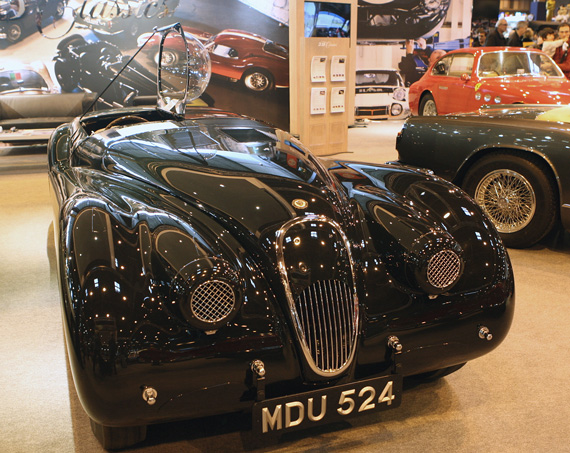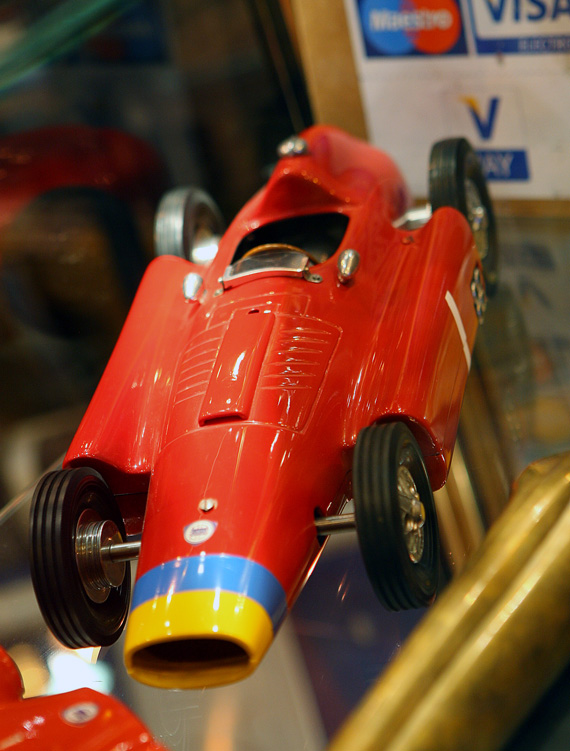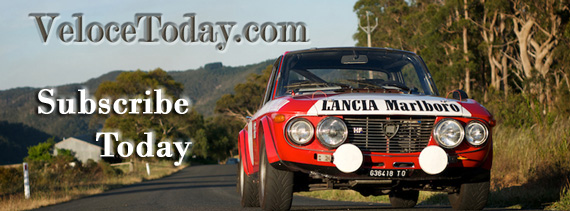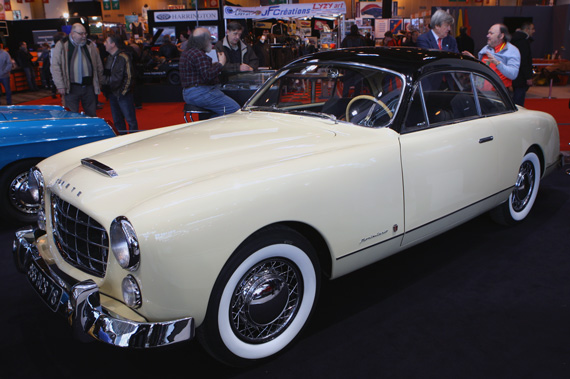
1955 Simca Comete Monte Carlo with bodywork by Stabilimenti Farina taking pride of place on the 'L adventure automobile Poissy Stand.
Story and photos by Jonathan Sharp
“Have you set the alarm dear?” my wife asks as it rings. Yes, what time is it? 3.30am; 3.30am! “You must be stark raving mad. Why would you want to get up in the middle of the night on a cold and very wet Saturday in England in February to go all the way in Paris to see cars that you have probably seen already!?”
The plane leaves Heathrow an hour late and the pilot sounds like Alan Prost. The landing into Charles De Gaulle is the bumpiest I can remember. Then it‘s public transport to the hotel, dump the cases and straight to the show. Things start to improve as does my mood as I walk into the exhibition hall. I wonder what delights await me.
As I walk to the media center the first thing I spy is “Babs”, Parry Thomas’s 1927 Land Speed Record car and next to it, but in a separate display coral, is the first Bluebird Land Speed record car – the 350HP Sunbeam. Both cars are nicely lit. The mechanics at the Beaulieu Motor Museum, where the Bluebird stays, had just completed a full mechanical overhaul which had taken over 2000 hours to complete. They had fired the engine in public for the first time in over 50 years a few days prior to the car’s departure. They also swung the starting handle and ran the engine at various times during the show for the public to enjoy.
Once I had obtained my pass it was time to get to see the goodies on display. Many of the major manufacturers pull out all the stops to put on world class displays of their heritage vehicles. Renault’s display celebrated the 50th anniversary of the Renault 8 Gordini, and 30 years of the Renault Espace. The R8 display contained various road and race versions. The Espace line up included all generations of that ground-breaking model plus the amazing Espace F1, essentially a Williams F1 car with an Espace body attached. The strangest car on the Renault stand has to be the project 900 from 1959, the precursor to the Espace.
Citroen displayed various DS models and their display also encompassed various French Citroen car clubs, so you might find a 2CV van near an SM Opera 4 door saloon by Chapron. Peugeot had the same sort of idea for their display with various Peugeot car clubs displaying around a central core display.
Mercedes, who are celebrating 120 years in motor sport, brought a number of great cars including the 1954 Reims-winning W196R Streamliner F1 car as driven by Fangio, and at the head of the line up the 1914 Rennwagen Grand Prix car, winner of the Lyon Grand Prix in the hands of Christian Lautenschlager.
All these displays are very much open to all; nothing is protected by barriers or security guards. It is nice to be sitting down on the edge of a display plinth eating your baguette with Fangio’s car two foot behind you. There may be some of the most amazing cars you will see on display but for a French man nothing comes before lunch, more of which later.
If I thought that the manufacturers had the best and largest stands and that the dealers would struggle to compete on the quality of their own stands, nothing could be further from the truth. The dealers’ displays are equally vast and this is where you find most of the gems on display – cars I never thought I would see and some I had never heard of much less seen before. On Lukas Huni’s stand I was transfixed by the Ferrari 250LM Stradale Speciale on display built in 1964 and one of only three built. I had foolishly believed only one was built and I had already seen it at Pebble Beach a few years ago but no what do I know – they built three. This example looked stunning finished in silver with French racing stripes down the middle of the car. I now need to see the third example to complete the set.
In the next row some Astons, namely a DBR4 Grand Prix car, a DB3S and a DBR1. In the corner an 1929 Hispano Suiza H6 3 position Cabriolet with coachwork by Hibbard and Darin, Americans who had worked with Le Baron before moving to Paris.
Lukas Huni had a fantastic Lancia retrospective display; a jaw-dropping line up of proper Lancias ranging from a 1924 Lambda Torpedo to two examples of the Stratos. Even the more humble Fulvia was a rare 1600HF Fanalone. My Flaminia-owning pal was stunned by the four Flaminias on display; the 1959 pre series Zagato example, the four-door Berlina, the Pinin Farina coupe and a Touring convertible. Plus a lineup of Aurelias including a 1955 B24S American, a B12 saloon and two B20 Coupes. I nearly forgot the D24 sports racer. This example, chassis 0005, was the winner of the 1954 Targa Florio in the hands of Taruffi and the Porto Grand Prix in the hands of Villoresi. The car was later given to Eva Peron and is the only original D24 in private hands.
Spread around other dealer’s stands I came across many other stunning and rare cars. On JD Classic’s stand a rather fetching Jaguar XK120. Ah but not simply a rather nice road car, oh no, that would be too easy; this example was the 1952 Jabbeke Land Speed Record Bubble car. This car took a class win and second overall in that year’s “Rallye International Des Alpes” but topped that in 1953 when Norma Dewes drove it over the flying mile at 173.159 miles an hour. Next to it, Fangio’s personal C type Jaguar.
On the Borrani France stand a Bucciali Cabriolet TAV30 from 1930 with bodywork by Saoutchik. On Peter Weisners stand, a Ferrari 206SP, a Bugatti T59 and a Maserati Birdcage.
The show itself was built around four major displays. The Alpine collection of Jean Rédélé (written up by Roy Smith in VT last week); a commemoration of the start of World War I; 35 years of the Paris Dakar, which I missed, and a major collection of cars from the Maharajas. Most of them not that pretty with various styles of bodywork adorning various Rolls Royces to allow them to go shooting tigers, but I did like the Aga Khan’s 1925 Alfa Romeo RLSS and the Rolls Royce EX17 originally owned by Maharaja Hari Singh Bahadur, one of 26 Rolls Royce Motor Cars owned by his family.
The Louwman Museum also brought along the Swan Car of 1910. Originally the brainchild of Calcutta resident and eccentric Robert Nicholl “Scotty” Matthewson, the car, it was said, made women scream and oxen, elephants and natives take off in terror in all directions at the sight of it. The who’s who of Calcutta was less than amused and the car was subsequently banned from the roads of Calcutta. Scotty, who had spent an amount equivalent to the price of six Rolls Royce Silver Ghosts then sold the car to the Maharaja of Nabha. The Maharaja’s 1920 Cygnet electric car which he used to drive around palace grounds was displayed next to it.
As is normal these days an auction was held during the show. Spread over two days Artcurial offered many a fine example. As I left the auction area the girls on the desk insisted that I take a catalogue (but Monsieur you are press !), well four catalogues actually which when I got home weighed over 8 pounds.
For those with money to burn had plenty to tempt them, everything from stunning works of art to jewel-like hand-built model cars. A favorite stand of mine contained various dioramas made up of models. The paddock of the 1967 24 hours of Le Mans and Captain George Eyston’s team with Thunderbolt, his Land Speed Record Car on Bonneville Salt Flats in the 1930s, was particularly impressive. My pal was very much taken with a plastic 1960’s Italian glow plug-engined model of a Lancia D50. However when he learnt that the price was 3000 euros he decided to pass as he had already bought a new Carrozaria Touring badge and owners hand book for his Flaminia. If you had the money then you could have bought an operator’s handbook for a Lamborghini 350 GTZ, the telegram sent by The Duke of Edinburgh to the BRDC to congratulate Mike Hawthorn on winning the World Championship in 1958, a coffee table made from a Dino V6 engine, an old tin of Lamborghini tractor oil, or just a replacement steering wheel for your Peugeot 403.
Food is very important in France so my pal insisted that we sit down to a proper lunch on Sunday. No cheese and pickle rolls on the hoof for him, and this being Paris the exhibition hall contained a rather nice restaurant on the second floor, so a good 90 minutes were spent enjoying two courses and a rather fine bottle of red wine. This may explain why I missed the Paris Dakar display. So after two days at the exhibition I headed back to the airport with sore feet and a bad back (the auction brochures probably did not help) but my early start had been greatly rewarded.
